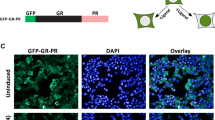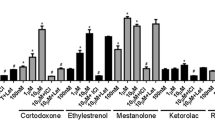Abstract
A number of chemicals are present in the environment, and some synthetic chemicals may disrupt endocrine function of wild animals and humans. An effective procedure to screen chemicals for endocrine modulating activity has been needed to ensure the safety of chemicals, and the reporter gene assay technique may provide a powerful tool for screening endocrine-disrupting chemicals. We have developed a high-performance reporter plasmid that can trigger high androgen-dependent induction with high selectivity by using mouse mammary tumor virus (MMTV) androgen-responsive elements and a partial fragment of the rat α2u-globulin promoter region. This new type plasmid can induce higher transcriptional activation than a commercial PGV-P-based construct bearing the SV40 promoter fragment, and the basal induction level of this plasmid is much lower than that of the PGV-P-based construct. Moreover, only androgen derivatives could selectively induce a high response in the reporter gene assay with the new reporter plasmid. This new type of reporter plasmid, ARE-AUG-Luc+, should be of value in endocrine research and in screening to identify endocrine-modulating chemicals.





Similar content being viewed by others
References
Balaguer P, Francois F, Comunale F, Fenet H, Boussioux A-M, Pons M, Nicolas J-C, Casellas C (1999) Reporter cell lines to study the estrogenic effects of xenoestrogens. Sci Total Environ 233:47–56
Balaguer P, Boussioux A-M, Dimerpence E, Nicolas J-C (2001) Reporter cell lines are useful tools for monitoring biological activity of nuclear receptor ligands. Luminescence 16:153–158
Boffelli D, Zajchowski DA, Yang Z, Lawn RM (1999) Estrogen modulation of apolipoprotein(a) expression. Identification of a regulatory element. J Biol Chem 274:15569–15574
Earl-Gray L Jr (1998) Tiered screening and testing strategy for xenoestrogens and antiandrogens. Toxicol Lett 102–103:677–680
EDSTAC (Endocrine Disruptor Screening and Testing Advisory Committee) (1998) Final report. Available via EPA http://www.epa.gov/scipoly/oscpendo/history/finalrpt.htm
Gagne D, Balaguer P, Dimerpence E, Chabret C, Trousse F, Nicolas J-C, Pons M (1994) Stable luciferase transfected cells for studying steroid receptor biological activity. J Biolumin Chemilumin 9:201–209
Kulkarni AB, Gubits RM, Feigelson P (1985) Developemental and hormonal reguration of α2u-globulin gene transcription. Proc Natl Acad Sci USA 82:2579–2582
Kurtz DT, Sippel AE, Ansah-Yiadom R, Feigelson P (1976) Effects of sex hormones on the level of the messenger RNA for the rat hepatic protein α2u-globulin. J Biol Chem 251:3594–3598
Miller S, Kennedy D, Thomson J, Hans F, Smith R, Ing N, Piedrahita J, Busbee D (2000) A rapid and sensitive reporter gene that uses green fluorescent protein expression to detect chemicals with estrogenic activity. Toxicol Sci 55:69–77
OECD (Organization for Economic Cooperation and Development) (2001) Third meeting of the validation management group for the screening and testing of endocrine disrupters (mammalian effects). Joint meeting of the chemicals committee and the working party on chemicals, pesticides and biotechnology 2001. Document ENV/JM/TG/EDTA(2001), OECD, Paris
Roy AK, Neuhaus OW (1967) Androgenic control of a sex-dependent protein in the rat. Nature 214:618–620
Roy AK, Chatterjee B, Rao KVS, Murty CVR, Sarkar FH, Majumdar D (1987) Androgenic regulation of hepatic gene expression. J Steroid Biochem 27:1129–1134
Takeyoshi M, Yamasaki K, Sawaki M, Nakai M, Noda S, Takatsuki M (2002) The efficacy of endocrine disruptor screening tests in detecting anti-estrogenic effects downstream of receptor-ligand interactions. Toxicol Lett 126:91–98
Vinggaad AM, Joegensen ECB, Larsen JC (1999) Rapid and sensitive reporter gene assay for detection of antiandrogenic and estrogenic effects of environmental chemicals. Toxicol Appl Pharmacol 155:150–160
Yamasaki K, Takeyoshi M, Yakabe Y, Sawaki M, Imatanaka N, Takatsuki M (2002) Comparison of reporter gene assay and immature rat uterotrophic assay of twenty-three chemicals. Toxicology 170:21–30
Zhang Z, Teng CT (2000) Estrogen receptor-related receptor α1 interacts with coactivator and constitutively activates the estrogen response elements of the human lactoferrin gene. J Biol Chem 275:20837–20846
Acknowledgements
We wish to thank Ms. Nobuko Mitoma, Ms. Harumi Hada and Ms. Miyoko Kumagai for their skillful technical assistance
Author information
Authors and Affiliations
Corresponding author
Rights and permissions
About this article
Cite this article
Takeyoshi, M., Kuga, N. & Yamasaki, K. Development of a high-performance reporter plasmid for detection of chemicals with androgenic activity. Arch Toxicol 77, 274–279 (2003). https://doi.org/10.1007/s00204-003-0437-z
Received:
Accepted:
Published:
Issue Date:
DOI: https://doi.org/10.1007/s00204-003-0437-z




